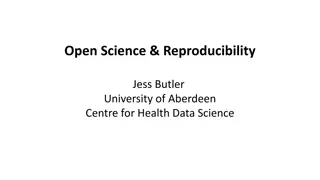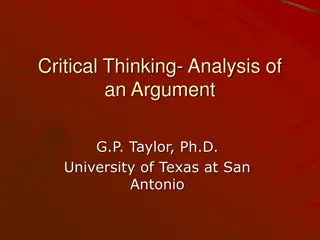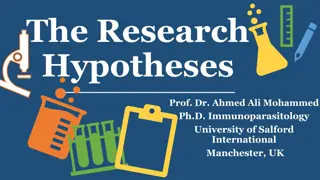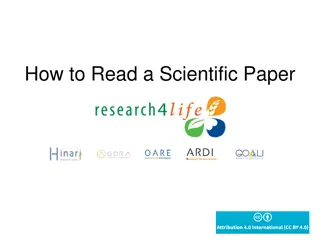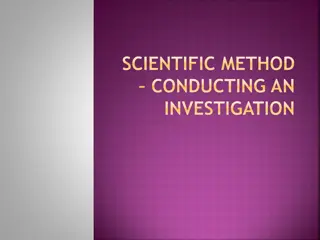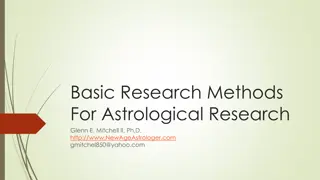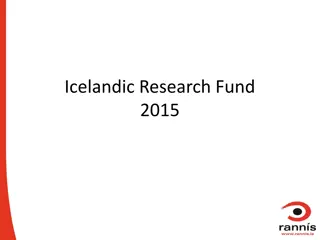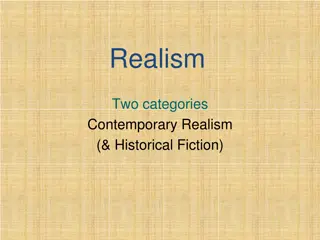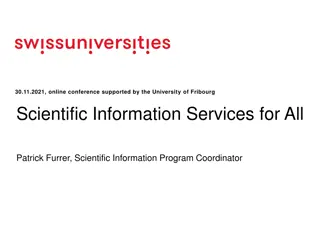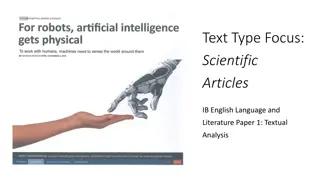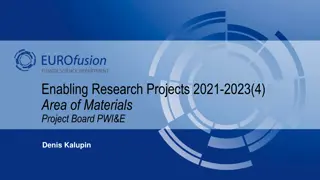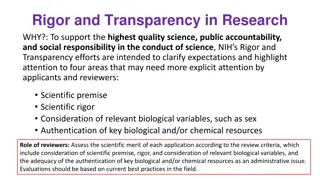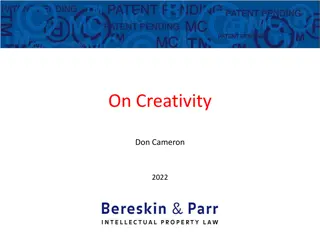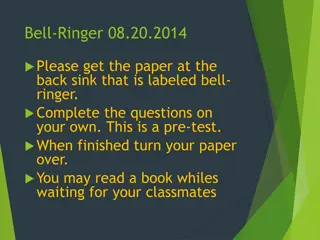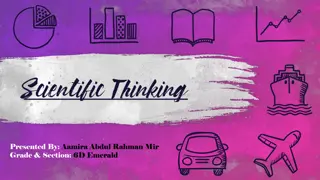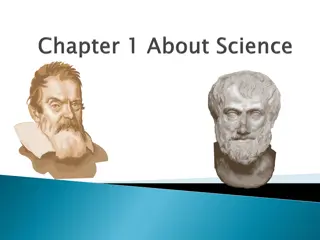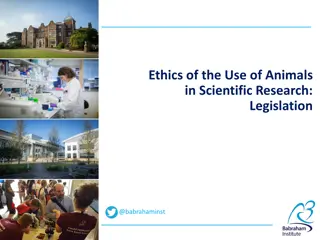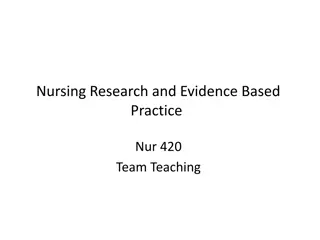Insights from Contemporary Scientific Research
This literature review delves deep into the realm of scientific studies, unveiling the latest findings and trends. It offers a comprehensive analysis of various research works, providing valuable insights and perspectives that shed light on current scientific advancements across different domains. Readers will gain a profound understanding of the evolving landscape of scientific research and its impact on various fields of study.
Download Presentation

Please find below an Image/Link to download the presentation.
The content on the website is provided AS IS for your information and personal use only. It may not be sold, licensed, or shared on other websites without obtaining consent from the author.If you encounter any issues during the download, it is possible that the publisher has removed the file from their server.
You are allowed to download the files provided on this website for personal or commercial use, subject to the condition that they are used lawfully. All files are the property of their respective owners.
The content on the website is provided AS IS for your information and personal use only. It may not be sold, licensed, or shared on other websites without obtaining consent from the author.
E N D
Presentation Transcript
Scientific Literature Review
Overview: 1. 2. 3. 4. What is a Scientific Literature Review? How to write a Scientific Literature Review? Coherent Literature Reviews Final Tips
What is a Scientific Literature Review?
Scientific Literature Review: A scientific literature review is a critical account of what has been published on a topic by accredited researchers. It may be: A stand-alone assignment An introduction to an essay, report, thesis chapter, etc. Rationale for engaging in primary research. Part of research/grant proposals Writing a literature review will: Improve your topic knowledge Provide insight on your topic to others Demonstrate your data search abilities Demonstrate your critical analysis skills Demonstrate your communication/writing skills
Scientific Literature Review: A scientific literature review is not: A brief summary of each research article that you review Biased towards the outcome you would like for your research Compared to 1991, in 2008 three, eight, and forty times more papers were indexed in Web of Science on malaria, obesity, and biodiversity. The purpose? Scientific knowledge is not static Significant output of scientific publications Difficult to examine every single new paper in detail Scientists rely on regular summaries of the recent literature Literature reviews can lead to new insights It is important to understand how knowledge in a particular field is changing/developing
Scientific Literature Review: A scientific literature review should: Critically analyse a selected topic using a published body of knowledge through summary, classification, and comparison of prior research studies, reviews of literature, etc. Be related directly to the topic you are developing Provide a clear statement of the topic or problem Provide a clear range of research on the topic Provide an evaluation of the research Present results into a summary of what is and is not known Provide an indication of what further research is necessary Identify areas of controversy in the literature What is in a scientific literature review?
Scientific Literature Review: What is in a scientific literature review? Typically 3 sections! TIP: Wordcount Introduction: An overview of the topic under consideration, along with the objectives of the literature review. Introduction = 10% Main Body = 80% Conclusion = 10% Main body: Collates research into topical areas. Provide explanation of how research articles are similar to and vary from the other. Conclusion: Discuss the research with the best outcome, most convincing in its argument, which makes the greatest contribution to the understanding and development of topic under research . AND WHY YOU INCLUDED THAT INFORMATION??!!
How To Write A Scientific Literature Review?
How to Write a Scientific Literature Review? Development of the literature review requires four stages: 1. Problem formulation - which topic is being examined and what are its component issues? 2. Literature search - identifying relevant research 3. Data evaluation - determining which literature makes a significant contribution to the understanding of the topic 4. Analysis and interpretation - discussing the findings and conclusions of pertinent literature
1. Problem Formation Ask yourself questions like these: What is the specific thesis, problem, or research question that my literature review helps to define? What type of literature review am I conducting? Am I looking at issues of Theory? Methodology? Quantitative research (e.g. on the effectiveness of a new procedure)? Qualitative research (e.g., studies of loneliness among migrant workers)? What is the scope of my literature review? What types of publications am I using (e.g., journals, books, government documents, popular media)? What discipline am I working in (e.g. biomedical devices, disease detection methods, biological pathways, lasers)?
2. Literature Search & 3. Data Evaluation In assessing each source, consideration should be given to: TIP: Take notes while reading! Provenance - Author's credentials? Are the author's arguments supported by evidence (case studies, statistics, recent scientific findings, good experiments)? Impressions Interesting research Key Studies Contradictory Information Objectivity - Is the author's perspective fair? Is contrary data considered? Is information ignored to prove the author's point? Persuasiveness Is some of the author's theses/data more or less convincing? Value - Are the author's data/conclusions convincing? Does the work contribute in a significant way to an understanding of the field?
4. Analysis and Interpretation How good was my information seeking? Has my search been wide enough to ensure all relevant material is included? Has it been narrow enough to exclude irrelevant material? Is the number of sources I've used appropriate for the length of my paper? Have I critically analysed the literature I use? Do I follow through a set of concepts and compare appropriate information? Instead of just listing and summarizing research, do I assess them, discussing strengths and weaknesses? Have I cited and discussed studies contrary to my perspective? Will the reader find my literature review relevant, appropriate, interesting and useful?
Coherent Scientific Literature Reviews
Coherent Scientific Literature Reviews Aim for: TIP: Use the Essay Structure Template available online: Clear and cohesive essay that integrates the key details of the literature and communicates your point of view Use subheadings, especially in long reviews DCU Website Student Learning Online Resources Essay Template Use transitions to help trace your argument If your topic teaches across disciplines, consider reviewing studies from each discipline separately Check the flow of your argument for coherence
Essay Template Student Learning INTRO 10% of word count Go from the broad to the specific. Introduce the general topic, why it is an important area, then state what you will specifically do to investigate it further. Section 1 Sub-point 2 Sub-point 1 Sub-point 3 Section 2 Sub-point 2 Sub-point 1 Sub-point 3 Section 3 Sub-point 2 Sub-point 1 Sub-point 3 CONCLUSION 10% of word count Go from the specific to the broad. State the conclusions you can draw from the points you ve made in the essay, and connect this learning to the general topic. End by posing a question for future research in the field.
Writing the Introduction Define or identify the general topic, issue, or area of concern, thus providing an appropriate context for reviewing the literature. TIP: Use Introductions & Conclusions available online: Point out overall trends in what has been published about the topic; or conflicts in theory, methodology, evidence, and conclusions; or gaps in research and scholarship; or a single problem or new perspective of immediate interest. DCU Website Student Learning Online Resources Introductions & Conclusions Establish your point of view for reviewing the literature; explain the criteria to be used in analyzing and comparing literature and the organization of the review.
Writing the Main Body Group research topics according to common denominators and back up main points with research including reviews, research articles, theoretical articles, case studies, etc.). TIP: Use the Paragraphing & Signposting Doc available online: Summarize individual studies or articles with as much or as little detail as each merits, remembering that space (length) denotes significance. DCU Website Student Learning Online Resources Paragraphing Signposting Provide strong "umbrella" sentences at beginnings of paragraphs, "signposts" throughout, and brief why I included this information" summary sentences at end of paragraphs.
Writing the Conclusion Summarize major contributions of research and articles to the body of knowledge under review, maintaining the focus established in the introduction. Evaluate the main body of information reviewed, pointing out major flaws/gaps/inconsistencies in research and issues pertinent to future study. Conclude by providing some insight into the relationship between the central topic of the literature review and the proposed scientific endeavour. Provide closure so that the path of the argument ends with a conclusion of some kind. NOTE: A literature review in a thesis or dissertation usually leads to the research questions that will be addressed.
Final Note TIPS!! A scientific literature review should: Be a piece of discursive prose Organize the literature review into sections that present topics, including relevant theory. Not list all the material published, but instead show evaluation according to the guiding concept of your thesis or research question Show you understand the relevance and significance of the different publications, and how they relate to each other.
Final Note TIPS!! A scientific literature review should not be: A list describing or summarizing one piece of literature after another. It's usually a bad sign to see every paragraph beginning with the name of a researcher.
QUESTIONS ???
Acknowledgements This presentation was prepared based on the resources kindly made available online by: University of Santa Cruz http://guides.library.ucsc.edu/c.php?g=119714&p=780881 University of Toronto http://www.writing.utoronto.ca/advice/specific-types-of- writing/literature-review University of Minnesota Duluth http://www.duluth.umn.edu/~hrallis/guides/researching/litrevi ew.html The University of Wisconsin - Madison Writing Centre http://writing.wisc.edu/Handbook/ReviewofLiterature.html Monash University http://www.monash.edu.au/lls/llonline/writing/science/lit- review/index.xml





